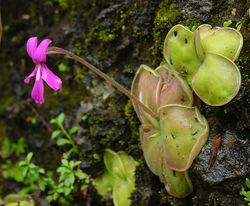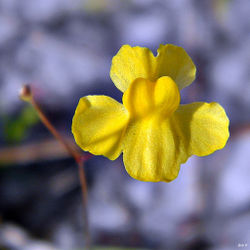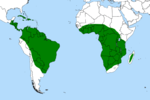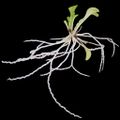Bladderwort family
| Bladderwort family |
|---|

|
| Scientific Classification |
|
| Genera |
|
| Zigzag bladderwort
(Utricularia subulata) |
The taxonomic Family Lentibulariaceae comprises a groups of carnivorous plants known as the bladderworts. They include three different genera (Genlisea, Pinguicula, and Utricularia). The genus Utricularia are perhaps the most fascinating of the carnivorous plants because of the way they obtain animals for their diet. This is also where the plants derive their name from; the small bladders (little air sacs called utricles), which like the venus flytrap, are an active carnivorous mechanism.[3]
The butterworts are carnivorous plants that thrive in the mountains as well as in the lowlands. They are in the genus Pinguicula. The butterworts have the simplest carnivory method, using their leaves to trap small insects. They produce a sticky mucus that covers the leaf, which is where these plants' common name—"butterworts"—came from.[4]
Genlisea are also know as corkscrew plants because of the shape of their roots, which contain traps for capturing prey; the roots also act as anchorage and absorb water. In their natural environment the Genlisea grow as terrestrials or semi-aquatics. They are a very recent discovery, only entering cultivation in the mid 1980's.[5]
Body Design
Lentibulariaceae, more commonly known as the Bladderwort family, are herbaceous annual or perennial plants. There are three genera: Utricularia, Pinguicula, and Genlisea with over 300 species, making Lentibulariaceae the most species-rich family of carnivorous plants. The family has been problematic for taxonomists because their vegetative morphology (somatic structures of plants), is extremely difficult to define.[4]
Pinguicula have short stems and their leaves are arranged in a tight rosette (a design, arrangement, or growth resembling a rose). Pinguicula are carnivorous plants, using their leaves to trap tiny insects. The upper surface of their leaves is covered in two types of glands. The first is the peduncular gland, which has secretory cells on top of a stalk cell that produce a sticky mucus that covers the leaf. The mucus adheres small insects to the leaves. After an insect is trapped, the secondary sessile glands release digestive enzymes into the inside of the insect, leaving the exoskeleton. The digested fluid is then absorbed through cuticular holes in the leaves.[4]
Genlisea are herbs with short, upright stems. Their leaves are dimorphic (occurring in or representing two distinct forms), with one forming as a thick basal (forming or belonging to a bottom layer or base) rosette on the surface (which is photosynthetic), and the other type (rhizophylls) that are subterranean. Rhizophyll leaves capture prey, act as anchorage, and absorb water.[4]
Utricularia have vegetative parts that are more challenging to distinguish than Genlisea's and Pinguicula's, and appear to consist of modified leaf-like structures and stems. Some species have subterraneous (being or operating under the surface of the earth) rhizomes, stolons or tubers. Utriculaira have no roots; however, terrestrial species have root-like stems, whilst aquatic species do not. The leaf arrangements vary widely, from rosettes, alternate, opposite or verticillate (forming one or more whorls) at stolon nodes. The leaf shapes can be lanceolate, peltate, reniform, sessile (characteristic of plant parts which have no stalk), or petiolate. It is unusual for these plants to be without leaves.[4]
Life Cycle
Many Utricularia that live in ponds in temperate regions have a distinctive adaptation that allows them to have a perennial life cycle. It is a unique bud-like structure called a turion (a dense cluster of plant cells with almost fully formed leaves). Surprisingly, bladderworts do not have a protective layer around them but instead form an incredibly compact pseudo-terminal bud (seemingly the terminal bud of a twig, but actually the upper-most lateral bud with its subtending leaf scar on one side and the scar of the terminal bud often visible on opposite side) with numerous amounts of starch in it's tissues, that they are too dense to be buoyant. The bladderworts sink to a pond or lake floor and remain in a state of dormancy during the cold months until spring, when they rise to the top to sprout as fully functioning bladderwort plants.[6]
The common butterwort of the genus Pinguicula can be either annual or perennial. During spring, the common butterwort’s life cycle begins after the hibernacula (a bud, case, or protective covering that a plant uses to survive the challenging environmental conditions during a dormancy period) open, and its first carnivorous leaves begin to sprout. Those leaves are then followed by flowers which grow during the summer, and leaves are constantly being produced throughout this season. Near autumn or possibly earlier, if conditions are not harsh, the next bud case is revealed in the center of the rosette. The leaf producing then comes to an end and the old leaves slowly decay. The common butterwort, now a small bud case, is ready for winter and the beginning of the next cycle.[7]
The corkscrew plants can be annual or perennial. Most of the Genlisea will generously flower from spring to autumn, and if pollination occurs, abundant seed is produced. They can grow quite quickly, usually within a few months. Genlisea form small rosettes about 3 centimeters in diameter, with linear or spatulate leaves. [8]
Ecology
Lentibulariaceae can be located in rigid to tropical areas.[9] Their range extends across all or most of the world in their distribution, from sub-arctic to tropical forests.[4] They are usually found in wet marshy places or wetlands and are aquatic, terrestrial, or sometimes epiphytic (being a plant that lives on the surface of another plant).[10]
Pinguicula are generally terrestrial, but can ocassionally be epiphytic. They grow in the mountains as well as in the lowlands, thriving throughout the northern portion of the Northern Hemisphere, and are more common in Eurasia.[4]
Utricularia grow across varying habitats as aquatics, epiphytes, or terrestrials. They are native to boggy areas of Brazil, Venezuela, Guyana and Paraguay.[4]
Genlisea grow in wet terrestrial to semi-aquatic environments throughout Africa and Central and South America.[11]
Uses of the Pinguicula vulgaris
The Pinguicula vulgaris is notably well known in folk traditions for its reputed use to curdle plant milk. This can be done by pouring the milk over a strainer on which fresh butterwort leaves have been laid. The milk is then left for a day or two until it sours, becoming the consistency of yogurt. A small amount of the milk can be kept to produce more batches. It is also said that the leaves of the butterwort are infused in the milk for a period of time.[12]
Butterworts are rarely used in modern-day phytomedicine (herbal-based traditional medical practice that uses various plant materials in modalities considered both preventive and therapeutic), though they were commonly used in the past as purgatives in Wales. Their main use today is as a cough remedy. The leaves are antispasmodic (a pharmaceutical drug or other agent that suppresses muscle spasms) and antitussive (drugs or other agents that suppress coughing).[13]
The leaves of bladderworts are harvested in early summer as the plants flower and are dried for later use. The dried leaves can be used to make a medicinal tea for an effective treatment of whooping cough and throat irritations. In addition, people use the Pinguicula vulgaris for treating urinary tract disorders, including kidney stones and urinary tract infections. It is also taken as a treatment for fluid retention, spasms, and swelling; to stimulate gallbladder secretions; and to promote weight loss. The bladderwort is sometimes used as a poultice and applied directly to burned or swelling skin.[14]
Video
Gallery
References
- ↑ Classification for Kingdom Plantae Down to Family Lentibulariaceae USDA. Web. Accessed May 26, 2016. Unknown Author.
- ↑ Lentibulariaceae Wikipedia. Web. Accessed May 5,2016. Uknown Author.
- ↑ The Bladderworts Peculiar Plants. Web. Last updated December 10, 2009. Unknown Author.
- ↑ 4.0 4.1 4.2 4.3 4.4 4.5 4.6 4.7 Cooper, Tom. Lentibulariaceae (The Bladderwort Family) Tropical Biodiversity. Web. Published March 1, 2013.
- ↑ Pinguicula Vulgaris Seeds (Common Butterwort, Steepgrass, Valentine's Flower)(Cold Temperate) Rarexoticseeds. Web. Accessed May 26, 2016. Unknown Author.
- ↑ The Bladderworts Peculiar Plants. Web. Last updated December 10, 2009. Unknown Author.
- ↑ Pinguicula Vulgaris Seeds (Common Butterwort, Steepgrass, Valentine's Flower)(Cold Temperate) Rarexoticseeds. Web. Accessed May 26, 2016. Unknown Author.
- ↑ Genlisea Repens Seeds (Corkscrew Plant Seeds) Rarexoticseeds. Web. Accessed May 26, 2016. Unknown Author.
- ↑ Leslie Watson. The families of flowering plants DEscription Language for TAxonomy. Web. Last update April 13, 2016.
- ↑ Milliken, W., Klitgård, B. & Baracat, A. Neotropical Lentibulariaceae Neotropikey. Web. Accessed May 14, 2016.
- ↑ Genlisea Wikipedia. Web. Last updated April 24, 2015. Unknown Author.
- ↑ Pinguicula vulgaris - L. Plants For A Future. Web. Accessed May 22, 2016. Unknown Author.
- ↑ Pinguicula vulgaris - L. Plants For A Future. Web. Accessed May 22, 2016. Unknown Author.
- ↑ http://www.webmd.com/vitamins-supplements/ingredientmono-317-bladderwort.aspx?activeingredientid=317&activeingredientname=bladderwort BLADDERWORT] WebMD. Web. Accessed May 22, 2016. Unknown Author.






